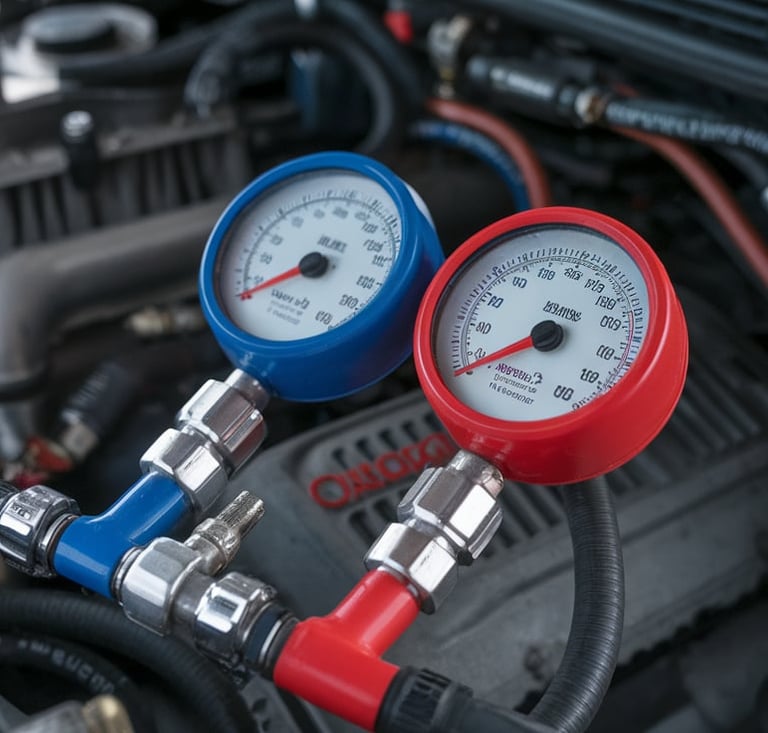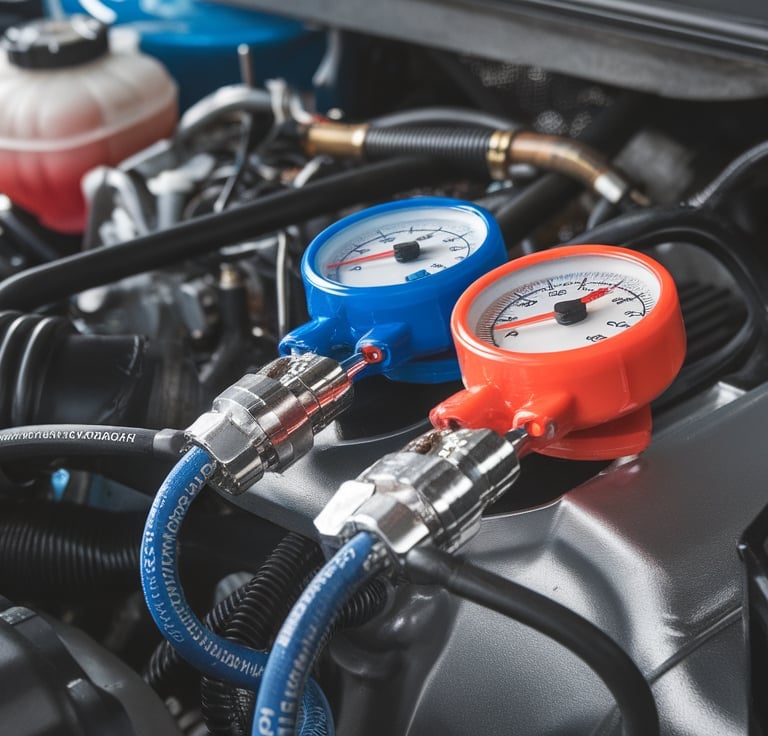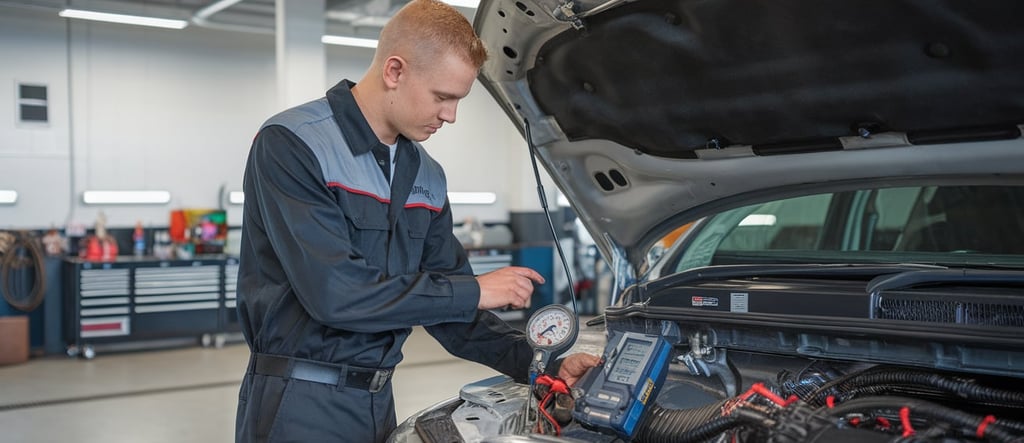What Is Vacuuming in Car AC Repair?
Why do so many AC jobs fail even after a fresh gas top-up? Often, it is because car AC vacuuming was skipped. Before adding refrigerant, the system needs a deep pull using a vacuum pump to remove moisture, trapped air, and any lingering contaminants. Without this step, cooling drops fast and if you're in Dubai, that is not something you want. Whether it's part of a full car AC repair or just refrigerant charging, vacuuming is what makes the cold air possible. Think your car AC not cooling properly? This might be the real reason. What Is Vacuuming in Car AC Repair?
8/21/20258 min read
Why Car AC Vacuuming Is the First Step to Proper Cooling
Before refrigerant is added, before pressure is tested, car AC vacuuming has to come first. Why? Because your AC system cannot handle refrigerant properly if it's filled with air, moisture, or old gas particles. A vacuum pump is used to suck all that out, pulling the system into deep vacuum, usually around 500 microns. That’s how you get rid of moisture that can freeze or turn acidic inside the pipes.
If you’re in Dubai and facing car AC not cooling issues after every refill, this might be the step that was skipped. Without vacuuming, refrigerant charging becomes guesswork, AC system pressure stays unstable, and the compressor keeps overworking. Vacuuming clears the system, resets the flow, and makes sure refrigerant gets a clean path to do its job. No vacuuming means no real cooling, especially in a climate where your AC has no room for mistakes.
Key Benefits of Vacuuming
Most people think a gas refill solves all cooling issues, but if the system wasn’t vacuumed properly, you're only delaying the problem. Car AC vacuuming isn’t about looks or speed; it's about survival of your compressor, your refrigerant, and your cold air. In Dubai’s extreme heat, moisture inside the AC lines is your system’s worst enemy, and a vacuum pump is the only tool that gets it out before damage begins.


Removes up to 98% of internal moisture
A deep vacuum pulls the system down to 500 microns or lower. At that level, water boils off, even at room temperature and gets extracted from all components.Protects compressor lifespan by 30–40%
Moisture mixing with refrigerant creates hydrofluoric acid, which attacks internal seals. Regular vacuuming before charging helps extend compressor life significantly.Stabilizes pressure at 29.92 inHg during pull
Proper vacuum pulls system pressure to near-perfect vacuum (29.92 inHg at sea level), ensuring no air remains before refrigerant is added.Refrigerant moves smoother through a dry system
Air bubbles cause fluctuating cooling and expansion valve errors. Drying the system allows refrigerant to flow at optimal superheat and subcooling levels.Leak detection becomes more accurate under vacuum
After vacuuming, if the gauge moves more than 1 inHg in 10 minutes, there's likely a leak. This simple test prevents wasted gas and poor cooling returns.
If your car AC is not cooling properly even after service, check if this step was skipped. In our region, skipping vacuuming is like skipping sunscreen, you will not feel the damage until it is too late. Pairing it with a complete car AC service in Dubai ensures your system is fully protected against hidden moisture and long-term performance issues.
Tools & Equipment Needed For Car AC Vacuuming
You can’t vacuum a car AC system with just any set of tools. It’s not a guesswork job, it’s a precision step that demands the right equipment. Whether you’re a DIY enthusiast or a technician in Dubai dealing with daily AC complaints, using proper tools ensures the car AC vacuuming process actually works, not just looks good.
Vacuum Pump (Minimum: 2-stage, 5 CFM or higher)
The heart of the process. A 2-stage vacuum pump pulls deeper vacuums (500 microns or less) and works faster, essential for hot, humid climates like Dubai. A single-stage pump often stalls around 1,000 microns, which is not enough to remove moisture completely.Manifold Gauge Set (With ¼ inch SAE fittings)
Connects to the AC system via low- and high-side service ports. Digital versions offer micron readouts, while analog gauges are still widely used. Look for clear PSI markings and built-in sight glass.Refrigerant Hoses (High-pressure rated, minimum 600 PSI working / 3,000 PSI burst)
Yellow hose connects the pump, blue to low side, red to high side. Always check for cracking, especially in summer, damaged hoses = false readings.Core Removal Tool (Schrader Valve Tool)
Helps remove the service valve cores temporarily to allow faster flow during vacuum. Speeds up the process by up to 40%.Micron Gauge (Optional, but vital for precision)
Built-in on some vacuum pumps or as a standalone device. Tells you when you’ve hit the target 500-micron mark, not just a “good enough” vacuum.AC Service Port Caps
Small but necessary. Keeps ports clean and sealed after servicing. Skipping them can lead to dirt ingress and false leaks later.
Using the wrong pump or skipping a micron gauge might not show up today, but the system will fail faster. If you're aiming for long-term cooling, especially under Dubai's heat, using the right tools for car AC vacuuming is not optional, it’s survival tech.
Step‑by‑Step Car AC Vacuuming Process
You’ve got the tools, now it’s time to pull the vacuum right. A lot of people rush this step and that’s exactly how moisture stays inside. Car AC vacuuming is not about speed. It’s about precision. Here’s how to do it the right way, step by step.
Locate the service ports
Open your hood. You’ll find two ports: the low-pressure port (larger line, usually with a blue cap) and the high-pressure port (smaller line, red cap). For vacuuming, you'll connect only to the low side.Connect the manifold gauge set
Blue hose goes to the low-pressure port. Red to high side (if you’re checking both). Yellow hose connects to the vacuum pump. Keep all valves closed before starting.Start the vacuum pump
Turn on the vacuum pump. Now slowly open the low-side valve on the manifold gauge. Leave the high-side closed during vacuum to prevent oil pull from the compressor.Pull vacuum for 30–45 minutes
Let the pump run until the system reaches 29.92 inHg or 500 microns. If you’re using a micron gauge, this is your gold standard. In Dubai’s humid conditions, you might need closer to 45 minutes to get the moisture out completely.Close valves and shut off the pump
Once the target vacuum is reached, close the low-side valve on the manifold. Then switch off the pump. Leave everything connected for now.Hold vacuum and monitor for leaks
Watch the gauge for the next 10–15 minutes. If the pressure rises more than 1 inHg, there’s likely a leak. If it holds steady, you're clear to move on.
Many AC issues in Dubai stem from skipping or rushing this process. Vacuuming is what clears the stage, without it, refrigerant charging won’t work properly, and your AC will fail again soon. This step isn’t optional. It’s the foundation.
Not sure if your AC system was vacuumed right?
Let us inspect it before more damage adds up. Our techs use deep-pull pumps, micron-level gauges, and we test every vacuum hold, no shortcuts. Visit us today for a proper car AC vacuuming service in Dubai, done the way it should be.
How to Know If Your AC System Has a Hidden Leak
Even after a full car AC vacuuming, if the refrigerant keeps leaking out, there’s a good chance the system has a hidden leak. It might not be visible to the eye, but it will show itself during a vacuum hold test. This test is simple, accurate, and can save you from wasting refrigerant and time.
Run the vacuum pump until you reach 500 microns or 29.92 inHg
Use your micron gauge or manifold set. Once it hits the target, shut the valves and turn off the pump.Watch the pressure for at least 10–15 minutes
If the needle stays still, the system is sealed. If it rises even 1 inHg, it means air is sneaking back in, which usually means a leak.Check hose connections and Schrader valves first
Before assuming the leak is deep inside, double-check your manifold gauge set, service ports, and vacuum pump connections.If pressure rises slowly, it could be moisture boiling off
In humid climates like Dubai, water inside the system can mimic a leak. Pull a longer vacuum (45 mins), then test again.Use UV dye or nitrogen if needed
If the vacuum test keeps failing, step into advanced leak detection using UV dye kits or nitrogen pressure testing.
A proper leak test should always be done beforerefrigerant charging. Skipping it means you’ll be back at the garage with the same car AC not cooling complaint in just a few days. This one step can save you hours of work, hundreds in gas, and a blown compressor down the line.


What Happens After Vacuuming? Recharging the System & Oil Top-Up
Once car AC vacuuming is complete and the system holds vacuum without leaks, you're ready for the final steps, refrigerant charging and, if needed, compressor oil top-up. These aren't just finishing touches, they're what actually bring your AC back to life. Skip them or do them wrong, and you’ll be back in the garage with another car AC not cooling complaint.
Start with the correct refrigerant
For most cars in Dubai, it's R134a or the newer R1234yf. Don’t guess, check the label under the hood. Using the wrong gas reduces efficiency and can damage the expansion valve or compressor.Charge through the low-pressure port
With your manifold gauge set still connected, attach your refrigerant source to the yellow hose. Open the low-side valve slowly. Let the gas enter while monitoring pressure.Always follow the exact charge weight
Every vehicle has a set refrigerant capacity, usually between 450g to 900g. Overcharging by even 100g can spike AC system pressure and reduce cooling.Top up compressor oil only when needed
If you replaced major parts like the compressor, dryer, or evaporator, you must replace or add PAG oil, typically 30–60ml per component. No oil? Expect early failure.Confirm performance with live pressure readings
At 40°C ambient (Dubai heat), expect low-side pressure to be 35–45 psi and high-side between 200–250 psi. Deviations may point to air pockets, oil blockage, or charge error.
Recharging without understanding these pressure behaviors or skipping oil check is like driving on a flat tire, you will not notice until it is too late. Done right, these final steps seal the deal, especially when supported by the right tools like a car AC vacuum pump that ensures the system is moisture-free before recharge.
When Should You Vacuum a Car AC System? (And Why Skipping It Wrecks Cooling)
Not every AC job needs new parts, but car AC vacuuming is almost always necessary. It’s not about how fancy the repair is, it’s about how open the system has been. If air or moisture entered the lines, you need to vacuum. Full stop. Skipping it? That’s how compressors fail early and your cooling fades fast, especially under Dubai’s brutal sun.
After opening the AC system for any repair
Whether it's a compressor, evaporator, or condenser replacement, the system has been exposed to air. You must use a vacuum pump before recharging to remove all moisture.After a full refrigerant evacuation
If the system was fully emptied due to a leak or maintenance, you can’t just refill it. Vacuuming resets pressure, dries the lines, and ensures safe refrigerant charging.After replacing any major component
New parts like AC accumulators or expansion valves usually come dry. If you don’t vacuum, trapped air will reduce performance and cause car AC not cooling issues soon after.If you're unsure how long the system was open
Even a 10-minute exposure to humid air allows moisture in. That moisture later turns to acid. A 30–45 minute vacuum cycle protects the internals and keeps AC system pressure stable.Before any refrigerant refill on used cars
For used or imported cars in Dubai, it’s smart to vacuum first, even if you’re not sure about the AC history. Better safe than replacing a blown compressor.
Skipping vacuuming might save 30 minutes now, but it will cost you days and dirhams later. This step is what separates quick fixes from proper car AC repair. Without it, moisture and air pockets stay trapped inside the system, leading to weak cooling and repeated breakdowns. A few extra minutes on vacuuming guarantees long-term reliability.


Still Dealing with Weak Cooling? Let’s Fix It the Right Way.
Still dealing with car AC not cooling even after multiple gas refills? Chances are, no one bothered to vacuum the system properly. Car AC vacuuming is what removes moisture, prevents acid buildup, and gives your refrigerant a clean path to work. Skip this, and you're just masking the real issue.
If you want lasting results, not just cold air for a week, get it done the right way. Book a proper vacuum and recharge service with pressure hold testing, or check out our DIY guides if you're going hands-on. Either way, make sure vacuuming is never skipped again.
Experts
Get your car air conditioner repair done by reliable experts in Al Quoz.
Dubai
Contact
Car AC Heroes
0506087150
© 2024. All rights reserved.
